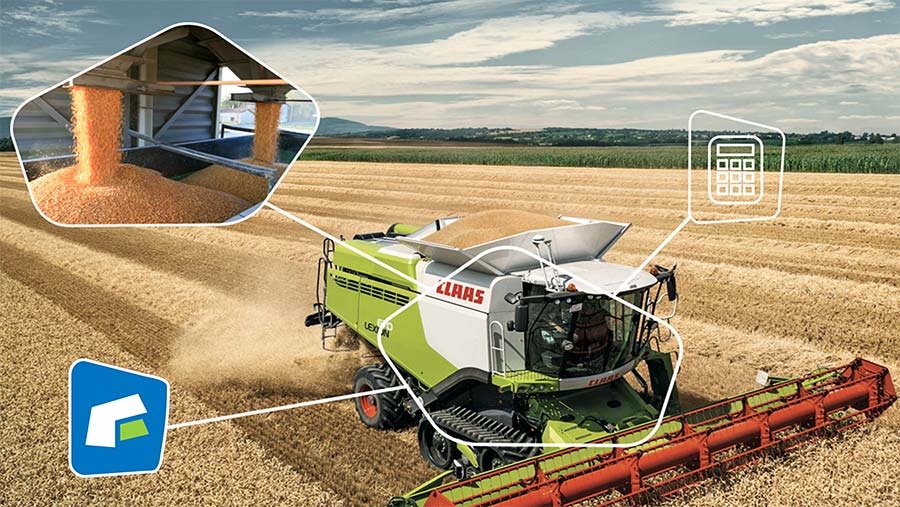Make the most of your combine’s yield data this harvest

What to do with your harvest data?
Despite many growers being awash with historical data from combine generated yield maps, only a small minority are using this data to its full potential.
We spoke with Ben Hatton, Farmplan’s key account manager, about how growers can make best use of their yield data.
Do you think there has been a change in the way growers are using yield data?
Yield mapping is becoming far more commonplace, as guidance has almost become standard practice and more combines are fitted with yield monitors.
However, there is a large gap between combines fitted with yield monitors and yield data that is imported into the office.
For many who do import yield data, this information is still simply used to confirm their thoughts on the yield of their fields.
However this is changing, with more growers looking to use this valuable data source to support on-farm decisions.
How many seasons’ data do growers need?
The more data you have the better. Looking back over multiple years is key to assessing whether your management practices are giving you the desired results.
Within Gatekeeper, for example, five years is a good base to start building normalised yield maps; however, even a single year’s yield data can help growers make better informed decisions.
Even a single year’s yield data can help growers
How can yield data be used to adjust inputs?
That’s the million dollar question and I don’t believe there is one answer.
This is where growers must start with some evidence – such as the yield data – and either draw conclusions or make further investigation, for example, is the low yielding area due to factors that can be changed or is it down to a localised, environmental condition?
If it is nutrient or a compaction type of problem, then changes to management practices could be implemented relatively quickly. If it is the nature of the soil type, then adjusting inputs may not make that much difference.
The grower must have a strategy in mind and use agronomic advice to support their approach. Returning applied data from variable applications can also be useful.
What else can yield maps be used for – can they realistically guide future cultivations?
No one piece of data will ever give you a clear guide when used in isolation; however, it can be used to reinforce what you already suspect and it can certainly clarify the extent of a problem.
Your analysis will become more accurate and useful as the volume of spatial data you collect and import increases.
And for growers not collecting spatial data, are yield maps still useful?
Yield maps can definitely still support on-farm decisions without spatial data. I was with a customer a few months ago who had been approached about putting solar panels on their fields.
So we ran field margin maps to identify which fields were the most profitable and were able to identify which fields to lease out.
We have even helped customers make purchase decisions. In one example, we used yield maps to help us understand establishment rates and then used this information when deciding which drill to purchase.
You’ve mentioned about not using yield maps in isolation. How important is it to support yield maps with other field survey information?
It is very important to combine yield with other sources of information as reliance on one data source may mask or hide certain issues in the field.
Precision farming data should be used in conjunction with agronomic and local knowledge.
Gatekeeper removes the integration burden for many growers
It can be difficult to import yield maps, can’t it?
This can be a challenge but great progress has been and continues to be made.
Gatekeeper has always been at the forefront of compatibility and can handle the majority of data file formats to make growers lives easier.
This removes the integration burden for many growers ensuring that key data such as field lists and boundaries can be exchanged between machines.
What is the least a grower starting from scratch would need to spend to adopt an input system based on yield maps?
The financial investment will depend on a number of variables, but will be minimal when compared to the cost of not using this data to support their decisions.
The real spend is in time. Without a clear strategy, time will be wasted. That being said, there are ways to use this data without investing too much time.
Farmplan, for example, offers a ‘harvest data management’ package, which takes much of the workload away from the grower.
The returns for growers who adopt this approach will not just monetary – reduced inputs, less fuel, maintenance and reduced operator time – but also environmental, helping improve soil health and wildlife conditions.
Linked to this, the adoption of precision farming technology also increases farming safety, with GPS and Autosteer reducing drive fatigue at critical times of the year.
Gatekeeper |
Harvest Data Management |
|
Why spread your data and plans across multiple systems, when you could use just one? Gatekeeper is the UK’s most popular, complete and independent crop management solution, compatible with all leading brands and already used by growers to manage 2.4 million hectares. Watch the Gatekeeper demo |
Save time before, during and after harvest. Receive support from experts and an in-depth post-harvest report identifying yield trends, cost of production and a range of other reports, presented in a clear and simple format. Find out more about Harvest Data Management |
